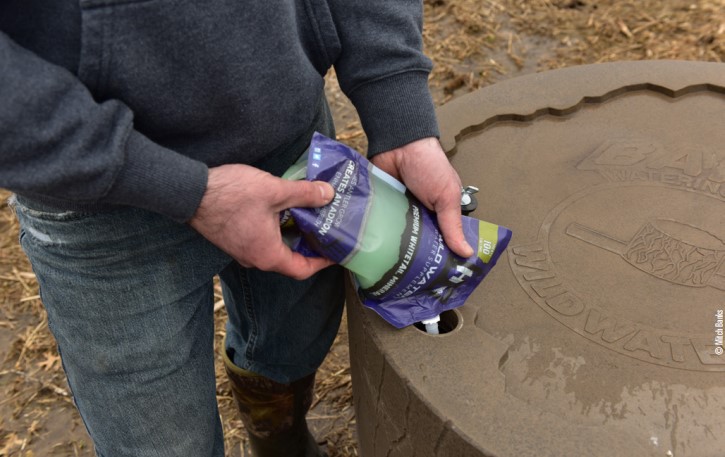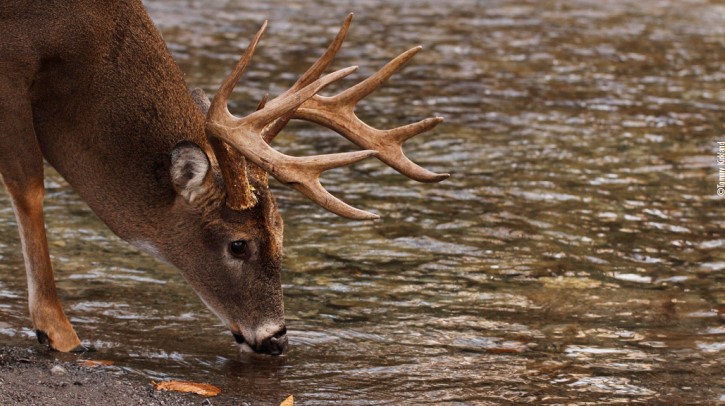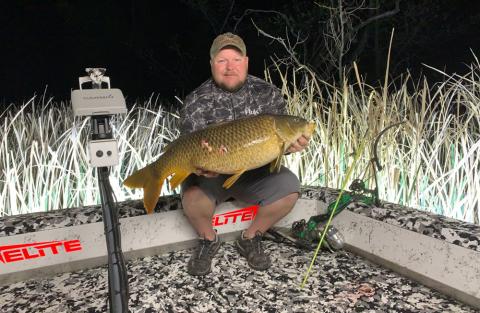Mitch Banks | Originally published in GameKeepers: Farming for Wildlife Magazine. To subscribe, click here.
I often get asked, “What is the most important tool when it comes to deer management?” My answer is twofold: water and nutrition. As a land manager, I grappled for years with a way to effectively provide those vital parts to a deer herd simultaneously. I asked my team at Banks Outdoors: Can we provide deer with water and minerals at the same time?
That simple question is what spurred Banks Outdoors to conceptualize our revolutionary Wild Water Supplement, a mineral additive designed to mix into water, providing your deer with not only year-round hydration, but the minerals they need to stay healthy. It pairs perfectly with our Wild Water trough delivery systems, but works with any water container.

Whether it’s the middle of summer or the peak of the rut, proper hydration is a crucial aspect of deer health. I’ve rarely found deer to stray too far from a reliable water source at any time of the year. And providing the many nutrients deer need, whether through mineral sites or supplemental feeding, strengthens the herd. This is especially true in the spring and summer when fawns are developing and bucks are growing their antlers.
The added bonus is that in addition to being beneficial to a deer’s health, Wild Water Supplements also act as an attractant. Through our own testing, we’ve found that by adding Wild Water to our favorite watering holes, we were able to lure in more deer to that location and keep them coming back consistently. This was echoed from numerous hunters in the field throughout the course of the year. The deer on their properties were consistently visiting water sources infused with Wild Water, just as they would a food plot. Many of them quickly found they could hunt these locations - and quite a few found success in doing so.
This supplement is very attractive to whitetails because of sodium concentrations. Salt is an important mineral deer need during summer, but it also adds flavor they can’t resist. There are no flavor additives beyond that. The ingredients also include calcium, manganese, copper and zinc.
The most obvious application for Wild Water begins during the spring and summer. In the warmer months, deer lose water through their urine, droppings and breathe while panting. When the temperatures rise; their need for water increases. A whitetail needs about two to three quarts of water per day, per 100 pounds of body weight. In hotter climates, it could be more.
At the same time, watering holes are prone to drying up. Of course, at certain times of the year, deer are gaining some water through their plant-rich diet, but that may not be enough to fully quench their thirst. Some plants contain less moisture than others. In desert environments or areas stricken with drought (as has been common in several parts of the country in recent years) supplementing water is key to whitetail survival. A water trough located near a bedding area or a food source is an ideal place to ensure your herd is properly hydrating.
Whitetails lack sodium due to their plant-rich diet during the warmer months, and will actively search for sources of salt in the soil. The typical way to provide sodium is through a salt lick. Of course, most salt licks contain minerals like calcium to further increase nutrient intake. Sites are typically established in the spring and come in three forms: granular, block and liquid, which typically incorporates into the soil as it deteriorates. Often, this requires bulky bags to cover an area enough for multiple deer to utilize.
Wild Water Supplement comes in a one liter pouch that will treat 100 gallons of water. Pour the recommended amount into your watering system or small pond and call it a day. Your deer will stay hydrated and because they must have water, will be consistently taking in the minerals they need throughout this crucial growth period. By monitoring your watering troughs you can ensure your herd is getting the nutrients they need.
Spring and summer is a time of replenishing after a long winter and a key growth time for whitetails at all stages of life. Bucks are growing their antlers, which are comprised mostly of calcium, phosphorus, magnesium, potassium, iron and zinc. Lower concentrations of these key minerals in a buck’s diet can lead to delayed velvet shedding and antler growth. When bucks are provided with Wild Water® Supplements, this can aid in their growth, as well as their immune and digestive systems.

It’s not just bucks that benefit from supplementary minerals, does need calcium throughout the duration of their pregnancy, and the need continues after they give birth. Wild Water Supplements aid in a doe’s bone growth, milk production and metabolism. Fawns and yearlings benefit from calcium as their skeletal systems develop. Providing them with supplemental minerals in accord with active habitat management can ensure your deer herd is taking in with the minerals necessary to reach their full potential.
As the weather cools and hunting season sets in, we tend to forget about both hydration and supplementing nutrients for the herd. We focus our attention on providing food or locating natural feeding areas for harvest opportunities. We hang our stands and place our bets on them.
Of course, these locations often offer excellent opportunities, I’m not arguing against that. But having an active water source while separate from where they are feeding provides you with another site in your inventory. It increases your options for places to hunt when the conditions may not favor other ambush locations.
Also, whitetails routinely visit water during the day; especially if it is a site concealed within the timber or other cover, where with food plots they most often visit during low-light conditions, mainly at night. For those with limited food sources on their property, hunting over water can be a complete game-changer.
Deer are more likely to consistently visit a trough that’s between their bedding area(s) and food source(s). This can be one of the most consistent patterns whitetails will exhibit during the hunting season: bedding to water to food – and that’s just when it’s plain water. Wild Water® Supplements act as an attractant and the deer will readily visit these sites just as they do a food plot. From countless hunter observations, we understand that deer prefer to drink from a safe and consistent water source. Natural watering holes are anything but reliable in the summer. Providing a place for them to drink means you have the ability to always keep the whitetail herd hydrated.

The Wild Water trough delivery systems, which are capable of holding up to 300 gallons of water, supplies a clean and consistent source year-round, even when natural sources have long dried up. For landowners without reliable watering holes, troughs are invaluable.
As the rut begins, again, our minds aren’t necessarily focused on water. But the “water-heavy leafy-greens” from spring are not available, meaning deer won’t hydrate from their food, and they’ll have to locate unfrozen water sources. While the deer seem only interested in putting on the feed-bag, they’re also aware of where they can get an easy drink. And, of course, their need to replenish with nutrients never stops.
Then your herd’s focus changes to all about “perpetuation of their species” and the celebrated rut. Think about a top-performing athlete operating at high levels during a competition. They need constant replenishment of both nutrients and water. It’s no different for whitetails. A buck during the rut is operating at maximum capacity. He’s tired, hungry and thirsty. In the moment, he couldn’t care less, but eventually the hot doe he is chasing will be bred and he’ll be looking to recoup. Having a reliable place for him to drink near his core area will ensure he gets hydrated and replenished with nutrients. Bucks will also remain healthy enough to continue throughout the rut without succumbing to the elements, as can happen when deer are under stress and the weather is harsh.

Bucks actually go through a period of about 10 days to two weeks where they only eat about 10% of what they normally would. Most believe their dramatic weight loss is because of all their arduous activity during the rut (chasing does). While rut actions certainly add to their accumulated total weight loss, the main culprit is their complete focus on perpetuation of species which causes them to eat much less. During this time; however, they still must have water.
After the rut, the entire herd is looking to replenish what they’ve lost. Bucks are still licking their wounds and recovering, so during this time they tend to be “homebodies” and don’t typically stray far from their home ranges to get what they need – obviously unless they must. That’s when using watering troughs and Wild Water Supplements, as well as having ample food for them nearby, will really pay dividends. Your herd will recover quicker and have a better chance of making it through winter.
As winter transitions back to spring, the cycle begins again. While Wild Water will significantly impact your deer herd, keep in mind you still have to include a well-rounded management routine all year long. Don’t expect mineral supplements, those applied on a stump, to the dirt or incorporated into the water, to grow antlers into a trophy overnight. Wild Water Supplement is simply another tool in the big picture involving habitat and herd management.




























